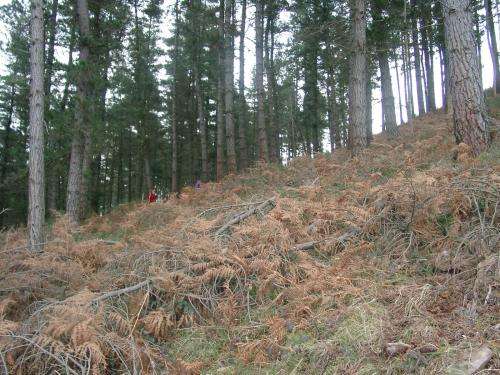It is recommended that nitrogen fertilizers not be used on radiata pine plantations

The Basque Institute for Agricultural Research and Development NEIKER-Tecnalia is recommending against using nitrogen to fertilize radiata pine plantations. This recommendation comes after having analysed more than 1,500 soil samples gathered in timber woodlands in Bizkaia and the north of Araba-Álava in recent years. The study suggests that the areas with a high probability of nitrogen deficiency are few and, therefore, the wholesale use of nitrogen fertilizers is not appropriate. The research centre experts propose having the characteristics of the soil analysed in the laboratory before applying fertilizer and, in any case, they believe it is preferable to maintain phosphorus and magnesium in a correct proportion when it comes to applying nutrients. Another of the conclusions is that 70% of the radiata pine soils studied have low organic matter values.
In order to help the forestry sector manage its plantations, the R&D centre has produced a set of maps each showing the presence of nitrogen, phosphorus and magnesium in Bizkaia and in the north of Araba-Álava; they have also produced a map with recommendations on the amounts of fertilizer to be applied according to each specific area.
Applying nitrogen fertilizers has a clear response in tree growth, but NEIKER-Tecnalia does not recommend its use in the area studied because the soils have sufficient nitrogen mainly due to the fact that woodlands absorb this gas from the atmosphere. Experts in the R&D centre's Department for the Conservation of Natural Resources likewise believe that the financial outlay involved in applying nitrogen is very high and, what is more, can lead to weakening and malformations in the woodlands.
Analyse the soil before applying fertilizers
Fertilizing using phosphorus, however, is recommended in virtually the whole area in the study as it may be helpful in obtaining better yields on radiata pine plantations. The amount of fertilizer needs to be adapted to each type of plot according to the recommendations stipulated on the NEIKER-Tecnalia maps.
The presence of magnesium has more unusual features. There are areas where it is clearly lacking and others where at the same time there is a high and a low probability that this chemical element will be lacking. This contradiction indicates that field samples need to be analysed in the laboratory to be able to make a suitable fertilization proposal.
As a general recommendation, the experts maintain that fertilization using phosphorus in the right doses, and using magnesium in specific areas, improves the rooting of the radiata pine and the capacity of the trees for taking up other nutrients from the soil for optimum production purposes. In any case, the best thing when it comes to proposing sustainable nutrition for woodlands is to take soil and leaf samples from the plots where one anticipates that fertilization could help production. When the samples have been analysed, it will be possible to gauge more accurately whether or not it is a good idea to apply fertilizers.
Integral, sustainable management
Correct fertilizing has to be part of integral, sustainable management. NEIKER-Tecnalia is committed to establishing timber woodlands in which the aim is not intensive exploitation, because Basque soils are characterised by their weakness, lack of nutrients and low organic matter content. Specifically, 70% of the 1,400 soil samples analysed displayed low values of this matter which is necessary to maintain soil biodiversity.
The plots of land studied had a texture with a high clay and lime content so they displayed an elevated risk of compaction. To these characteristics it is necessary to add that it is a very rainy area with steep slopes, which means the risk of soil degradation is very high. So timber woodland soils need to be sustainably managed.
The characteristics of the province of Bizkaia and the north of Araba-Álava make it necessary to maintain the organic matter and the mulch —natural fertilizer made up of dead leaves and other organic components— in the soil and to be particularly careful with machinery when carrying out work to prepare the land. Using them properly means significant financial savings in fertilizers and what is more, prevents soil degradation and water courses.
Provided by Elhuyar Fundazioa